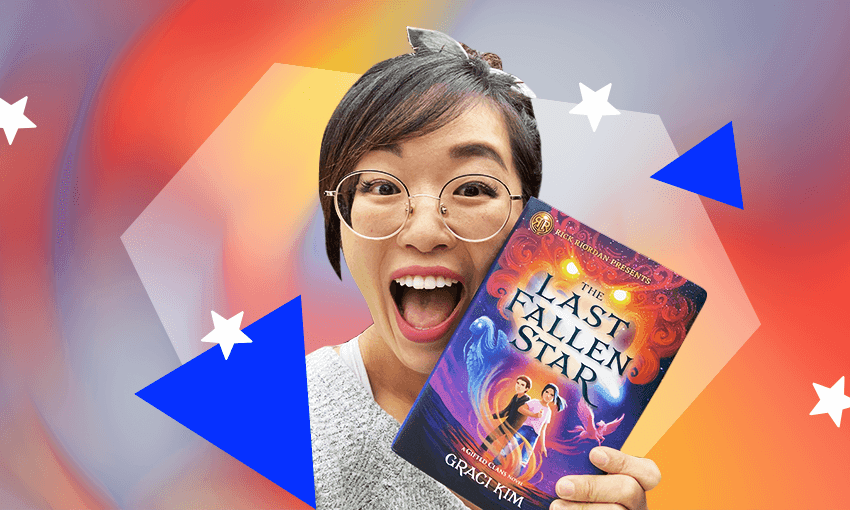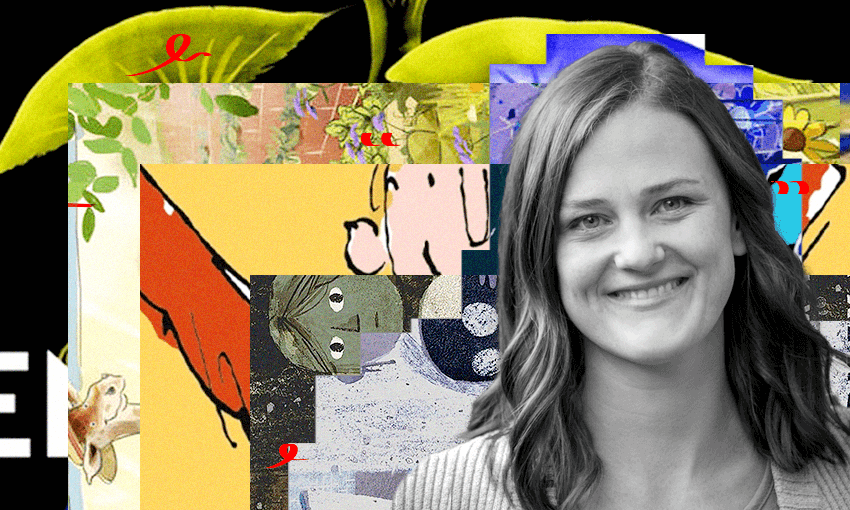The Auckland writer’s debut novel, a children’s book about Korean witches, has been optioned by Disney and just hit the New York Times bestseller list. She speaks with books editor Catherine Woulfe.
When you’re pitching a book you’re really selling two stories. There’s the novel itself, your precious baby. And then there’s you. Are you inneresting? Got some yarns? Most importantly: how are we going to boil you down into a blurb?
This is how Disney blurberised Graci Kim: “Graci Kim is a Korean Kiwi diplomat turned author who writes about the magic she wants to see in the world … In a previous life she used to be a cooking-show host, and once ran a business that turned children’s drawings into plushies.”
Those aren’t even the inneresting bits. So, the story of Graci Kim: let’s go.
Kim is 35. She lives in Hobsonville, Auckland, with her two-year-old daughter, Skye and husband, Neil. She writes full time now, allegedly – but she has a toddler, and nothing is truly full time except that. Although a lot of writing, of course, happens off the page. “The other day we were playing with unicorn marbles, they’re these squashy little marbles made with water. And I was like ‘Oooh!’ and I had an idea for the next book that involved magical marbles. I would never have thought of it otherwise.”
She genuinely enjoys the question “Where are you really from?” and the answer is she was born in Korea and moved to the North Shore with her family aged three. Her parents worked all hours and she and her sisters were largely raised by their halmoni, their nana. (Kim wrote for New Zealand Author magazine in 2019: “She was illiterate and uneducated; suspicious and eccentric. She also didn’t speak a lick of English. Yet she raised us with enough unconditional love to power a nation.”)
The family moved again, out west, when she was at primary school, because on top of racial bullying – kids were spitting in her lunch, calling her “ching chong china man”, chasing her home – her teachers started taking her out of class to act as an interpreter for an influx of new immigrants. Uncool, but understandable, is her take on it now. She is far too nice.
Kim worked for the Ministry of Foreign Affairs and Trade for just over 10 years, with posts in Taipei and Beijing, constantly changing roles. “Generally speaking I worked on the trade and economic side, so APEC, New Zealand-China relations. At one point I worked on cultural and wine trade negotiations. Oh, that really was lovely.” She is an absolute straight-up dork about New Zealand. Loved representing us, loved telling people she was from here. Huh, I say. Must have been nice after being treated like an outsider when you were little. “Yeah, 100%. It was my badge of honour, and it was literally the reason I wanted to become a diplomat.”
She had other hustles. The plushies! “I was in a dull agricultural trade meeting one day, doodling monsters in my notebook, thinking the only thing that could make that meeting more interesting would be if that monster jumped off the page and became a real soft toy. I thought that was such a cool idea – bringing imaginations to life like that. So my boyfriend at the time (my now husband) and I created My Thingamybob, where kids could send us their drawings, and we’d work with local artisans in China to turn their drawings into real life soft toys.”
Also: the cooking show! That happened when she was posted in Taipei. “I missed home-cooked Korean food so much, so I started teaching myself and documenting it as a cooking show, while showing a bit of Taipei as well. It was called Graci In The Kitchen, where I cooked meals that matched your mood, i.e. what to eat when you’re stressed, when you’re heartbroken, when you’re homesick, that kind of thing. We filmed two seasons and it managed to get broadcast on Tastemade and the Food Channel, and got almost a million views in its first year.” (Feeling vulnerable? She recommends kimchi pancakes and butterscotch apples. Depressed? Taiwanese egg pancake pizzas.)
~
Kim was in her early 20s, on top of the world in Taipei, walking with a friend to deliver a birthday cake to another friend, when a concrete truck blew past her on a zebra crossing. It was so close her ponytail whooshed to the side. A thud. She turned to see a 12 year-old girl dead on the ground, and the girl’s mother hurt, unable to move, unable to reach her daughter, shrieking.
“I remember thinking – it was like 6pm on a Saturday and it was super busy, the roads were full of people – no one did anything. Everyone just watched. A few people called the police and stuff but no one actually went to help this woman.
“This mother was crying out, screaming for her child who she could see on the road in front of her … I went into the middle of the road. She was immobile, she could move her hands but nothing else. I just crouched down on the ground with her and held her hand. I couldn’t speak Chinese at the time so I didn’t really know what to say but I just kept saying ‘You’re not alone, I’m with you, I’m here, help will come soon … ‘“
The woman died in the ambulance. Kim later discovered that the woman’s younger daughter had been on a skybridge above the road and seen the whole thing.
“It just really fundamentally affected me.”
Shortly afterwards, Kim was at her next post, at the New Zealand Embassy in Beijing, when she realised she couldn’t read her emails properly. She thought it was time for a new contact lens prescription, but her optometrist sent her straight to an ophthalmologist, who said, “I don’t know how to tell you this but if you don’t get emergency surgery within the next 24 to 72 hours you’re going to be blind.”
She was blind, after the surgery, for some months. She calls it her time “living in darkness”. It was another reminder that life can change in a moment. “I couldn’t believe how different the world was. It was just little things – my dad put a cup of Sprite next to my bedside table at the hospital and I remember thinking the bubbles were so loud. And the sun streaming in through the blinds and warming my skin – I sat there and I would just laugh because it was such a delightful feeling. And hearing smiles in people’s voices … “ As her vision gradually returned she came as close as she’s been to a religious experience. “Everything was just so beautiful and the smallest things brought me such joy, and I thought, ‘This is the way you’re supposed to live this life.’”
On top of those traumas, her beloved halmoni died. “I realised: No. Enough.”
Kim came home and started to write. Witches, because she was obsessed with them. And big dollops of Korean culture and language, because it felt right. Like so many non-white writers, she wrote for the little kid she used to be, who read voraciously but had never found herself in a book.
Three years ago she delivered a moving TedX talk about why she initially used an anglicised pseudonym. There were pragmatics in play: “I feared I’d be written off as an ‘Asian writer’ who was too niche to reach a mainstream audience.” But further, Kim was the name that reminded her of being bullied, “the name that reminded me of strangers giving my mum the middle finger, mumbling ‘stupid Asian’ under their breath. And the one that echoed in my ears as I watched people throw eggs at my dad in his car, shouting at him to get out of their country and never come back. Kim had always been more than just a name. It had been a constant reminder of my otherness. My not-good-enough-ness.” One day, watching her dad beam with pride over an award she’d been shortlisted for, something clicked. “My name was not a shackle. My name was my history and my pride.” So: Kim.
Most writers loathe the business side of things. The strategising, the market research, the sell. They’d rather be writing. Kim gets a kick out of all of it, and treated her book as she would a startup. She networked. She threw herself into writer’s groups and online courses and critique partnerships, and set up a social media presence. Business plan: aim for the US, because it’s the biggest, and go for a traditional publisher, because marketing as an indie would be too hard.
The first book she wrote is called The Last Fallen Star and it is really very good. Pitched at tweens, but absolutely rich enough for adults, it’s kooky and kind, full of magic and food and textured relationships. It’s about a 12 year-old girl called Riley who thinks she was born saram – non-gifted, no magic – making her the odd one out in her family of healing witches. Of course she’s wrong about that. There are funny bits: “Her hair is swept up into a French twist, and she’s wearing a black turtleneck and jeans. She looks like a Korean female version of Steve Jobs, but with more hair.” There’s a spell gone wonky, and a quest, and a bestie, and a really cool setup where various clans of witches are pootling around just out of sight of normal society. There’s a portal to their world in an H-Mart and one in a bubble tea shop. There’s also a karaoke bar where Riley and her mates have to chant the BTS song Fake Love to break a glamour. Kim laughs. “Yeah. Can we avoid BTS? No.”
The book released in 2019 to solid reviews from big names like Kirkus, Entertainment Weekly and Publishers Weekly and was an instant indie bestseller in the US. It’s now rating 4.3 on Goodreads and last month it got a major boost – it was chosen by the biggest bricks-and-mortar bookstore in the US, Barnes & Noble, as a pick of the month. Hence, she thinks, its recent appearance at number 10 on the coveted New York Times list (it was number 10 on the monthly bestsellers among children’s middle grade hardcovers).
The book could well have still been in the slush pile were it not for a savvy workaround: Kim entered DVpit, a Twitter pitch contest helping marginalised writers get fast, focused attention from agents.
Three weeks later she had a US agent and after a few more rewrites (she hit 10 in total), a deal with publishers Disney-Hyperion. They worked with her to age the book down, from YA to “middle grade” – no one knows what that means, but loosely, let’s say eight to 13-year-olds. The book came to the attention of megastar Rick Riordan, who signed Kim up under his imprint Rick Riordan Presents, and helped with editing and marketing. (Never heard of him? Ask a 10-year-old: he’s the guy who wrote the Percy Jackson series, and carries incredible clout with kids.)
That first book deal was confirmed when Kim was in the middle of her 12-week antenatal scan. It was worth five figures; Kim got a further six figures for the next two books in the trilogy. Disney’s also optioned the series for a live-action TV series. Who knows whether that’ll get off the ground, but she has had talks with the scriptwriter, so maybe something real is ticking away there. I ask for detail about the money and instead of demurring like most writers would, Kim checks her spreadsheet. “If I amalgamate how much I’ve made and then split it into the years [since her first book deal in 2019], as an approximate I’ve been making about NZ$80,000 a year.” That’s not bad! “Yeah!”
She credits “thinking like a business person”, rather than a creative purist.
“Working in diplomacy I saw so many Kiwi businesses, tiny tiny Kiwi businesses, do so incredibly internationally because they were smart about it and they used their resources wisely and they honed in on what matters. They do extremely well, so why can’t we writers do exactly the same?”
The Last Fallen Star: A Gifted Clans Novel by Graci Kim (Rick Riordan Presents, $29.99) is available from Unity Books Auckland and Wellington.
To celebrate her NYT listing, Graci Kim is giving away 500 copies of The Last Fallen Star to teachers and school librarians. The second book in the series, The Last Fallen Moon, releases this week in the US and is expected to launch here in about six months.





